The Google Nexus 9 Review
by Joshua Ho & Ryan Smith on February 4, 2015 8:00 AM EST- Posted in
- Tablets
- HTC
- Project Denver
- Android
- Mobile
- NVIDIA
- Nexus 9
- Lollipop
- Android 5.0
Battery Life
It goes without saying that battery life is one of the most important aspects of a mobile device. After all, a mobile device isn’t really mobile if it can only be used for an hour before running out of battery. In order to test this, we turn to our standard suite of battery life tests, which include our web browser battery life test, along with some compute-bound benchmarks to characterize battery life across various use cases.
However, as the Nexus 9 introduces such a unique CPU architecture, I felt that it was necessary to try and adequately capture the full extent of battery life. To this end, I’ve introduced a new test that is really quite simple but important, as we can start to separate display power from everything else since it can often be the single largest consumer of power in a test. In order to do this, everything that could run during a test is disabled, and the device is placed in airplane mode with the display at 200 nits. A white image is displayed on the screen from a full charge until the device shuts down.
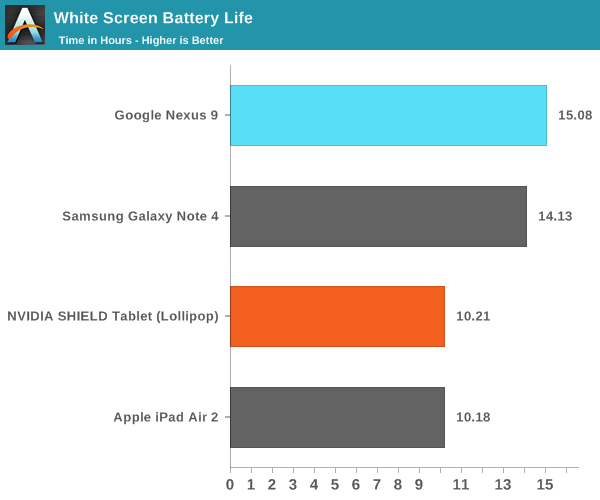
Interestingly enough, the display runtime on the Nexus 9 is about as good as it gets when compared to other devices for which we have data. I suspect we’re looking at the direct result of the large battery combined with an efficient display, as the Nexus 9 can last as long as 15 hours in this test compared to the iPad Air 2’s 10 hours.
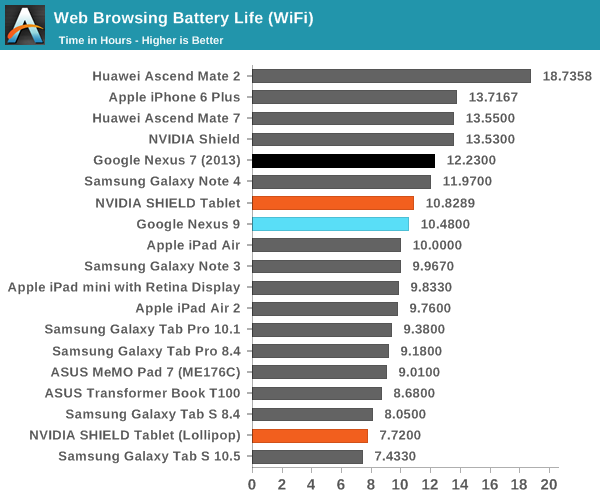
Unfortunately, the massive lead that we saw with the pure display test is significantly eroded in our web browser test. Our web test is primarily focused upon CPU, connectivity, and display efficiency. Seeing as how the Nexus 9’s display is far ahead of the iPad Air 2 and connectivity should be broadly similar in power efficiency, it seems that all of the efficiency gains from the display have gone into powering the Denver CPUs. It’s likely that process has a significant effect on this, so the more valid comparison is between SHIELD Tablet and the Nexus 9. At any rate, the Nexus 9 does manage to deliver solid battery life performance in this test which is definitely a good thing.
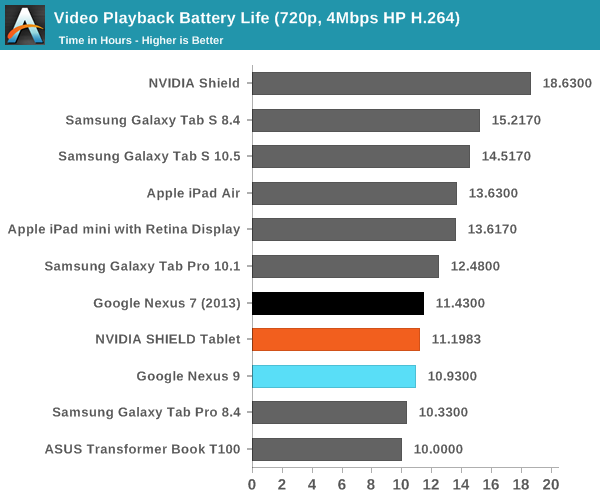
When we move to our pure video test, the Nexus 9 does have a minor regression when compared to the Nexus 7 (2013) and SHIELD Tablet. In this case, the AMOLED displays on the Galaxy Tab S line make for an easy victory due to the relatively high amount of black displayed in the content. The gap is closed between the two devices though, due to a reduced focus on SoC power.
While our web browsing test can give some idea of efficiency, there are often cases where more compute is directly used to support a better experience. To try and test for these compute-bound cases, we use Basemark OS II’s CPU battery life test and GFXBench’s T-Rex rundown for a GPU battery life test. As with the web browsing tests, these are run at 200 nits to keep things relatively equal.


In Basemark OS II, the Nexus 9 does a surprisingly good job as the CPU manages to keep incredibly high sustained performance. The large battery and efficient display seem to help to a significant extent.
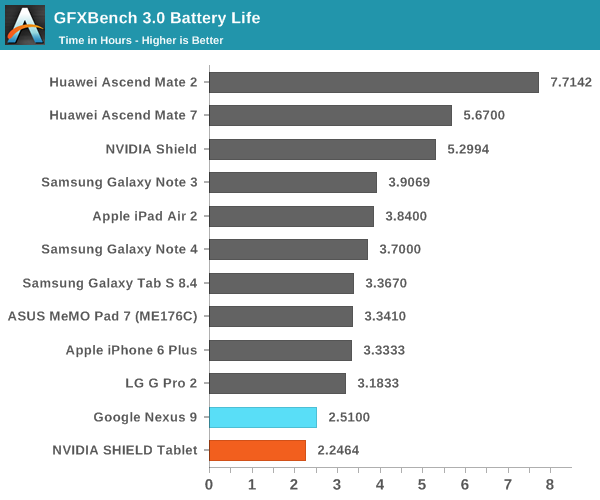
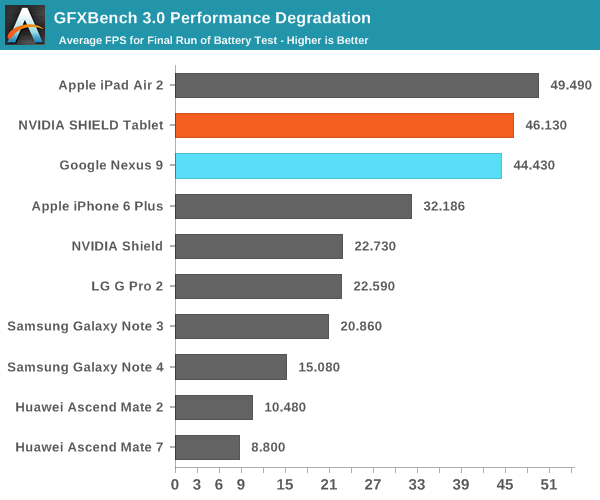
In GFXBench, it seems that not much changes overall. The GPU is definitely more power hungry than the PowerVR Series 6XT line-up and sustained performance is noticeably worse, but it’s in line with the SHIELD Tablet. End of run performance ends up a bit lower, but higher than one might expect. This is likely due to differing ambient temperatures. In practice, skin temperatures are about 45C in this test and localized to the top half of the device, and it’s likely that internal temperatures are around 80C as well. Seeing as how Tegra K1 can theoretically draw 33W in platforms such as the Jetson TK1 dev board with active cooling, it's incredibly impressive to see NVIDIA effectively keep such a powerful SoC within the constraints of a passively-cooled tablet.
Charge Time
While battery life is one part of the equation, charge time is an equally important aspect of overall battery life. To measure this, we measure the time from when charging begins to when the device reaches 100% charge. This is confirmed by taking measurements at the power outlet to make sure that power draw is below a certain level.
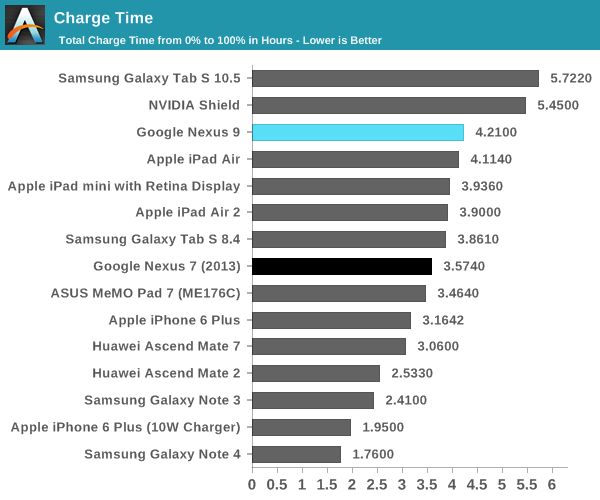
In this regard, the Nexus 9 is merely average for a tablet, although it does fall behind the competition as it uses a 5V, 1.5A charger for 7.5W instead of the 12-15W chargers that we’ve seen recently. It shouldn’t be a big issue, but in general this does mean that devices like the Galaxy Note 4 are actually better at battery life overall when compared to most tablets.










169 Comments
View All Comments
rpmrush - Wednesday, February 4, 2015 - link
I find the 4:3 aspect ratio a turn off. Why change now. There are zero apps natively designed for this in the Android ecosystem. Why would a developer make a change for one device? It just seems like more fragmentation for no reason. I'm picking up a Shield Tab soon.kenansadhu - Wednesday, February 4, 2015 - link
One example to drive my point: I bought kingdom rush and found out that on my widescreen tablet, the game won't fit the screen properly. If any, this will fit apps previously designed for ipads well. Hate to admit it, but apple has such a huge lead in the tablet market it's just reasonable for developers to focus on them first.melgross - Wednesday, February 4, 2015 - link
Well, there are almost no tablet apps at all for Android. One reason is because of the aspect ratio being the same for phones and tablets. Why bother writing g a tablet app when the phone app can stretch to fit the screen exactly? Yes, they're a waste of time, but hey, it doesn't cost developers anything either.Maybe goi g to the much more useful 4:3 ratio for tablets will force new, real tablet apps.
It's one reason why there are so many real iPad apps out there.
retrospooty - Wednesday, February 4, 2015 - link
You sound like you are stuck in 2012. Update your arguments ...UtilityMax - Sunday, February 8, 2015 - link
There will be more tablets coming with 4:3 screen. Samsung's next flagship tablet will be 4:3. As much as I like watching movies on a wide screen, I think it's not the killer tablet application for most users, and most people will benefit from having a more balanced 4:3 screen. It works better for web browsing, ebooks, and productivity apps.Impulses - Wednesday, February 4, 2015 - link
Most simpler apps just scale fine one way or the other... I think 4:3 makes a ton of sense for larger tablets, it remains almost exactly as tall in landscape mode (which a lot of people seem to favor, and I find bizarre) and more manageable in portrait since it's shorter.7-8" & 16:9 is still my personal preference, since I mostly use it for reading in portrait. Try to think outside of your personal bubble tho... I bought the Nexus 9 for my mother who prefers a larger tablet, never watches movies on it, yet almost always uses it in landscape.
It'll be perfect for her, shoot, it even matches the aspect ratio of her mirrorless camera so photos can be viewed full screen, bonus.
UtilityMax - Sunday, February 8, 2015 - link
I personally think about the reverse. Big tablets with 9-11 screens are often bought for media consumption. Because of that, it makes sense for them to come with a wide screen. For me, having wide screen for watching movies on the flights and in the gym was one of the prime reasons to buy a Samsung Galaxy Tab S 10.5, even though its benchmarks look only so so.However, a 9 to 11 inch tablet is too bulky to hold in one hand and type with another. It almost begs for a stand. So for casual use, like casual web browsing or ebook reading, a smaller tablet with a 4:3 screen works better. And so I went ahead and got a tablet with 4:3 screen for that purpose.
Impulses - Monday, February 9, 2015 - link
Valid points, obviously usage cases can differ a lot, that's the nice thing about Android tho... It doesn't have to conform to any one aspect ratio that won't fit everyone's taste.LordConrad - Wednesday, February 4, 2015 - link
I love the 4:3 aspect ratio. I primarily use tablets in Portrait Mode, and have always disliked the "tall and thin" Portrait Mode of traditional android tablets. This is the main area where Google has always fallen behind Apple, IMHO. This is the main reason I gave my Nexus 7 (2013) to my nephew and bought a Nexus 9, and I have no regrets.R. Hunt - Thursday, February 5, 2015 - link
Agreed. I understand that YMMV and all that, but to me, large widescreen tablets are simply unusable in portrait. I'd love to have the choice of a 3:2 Android tablet though.